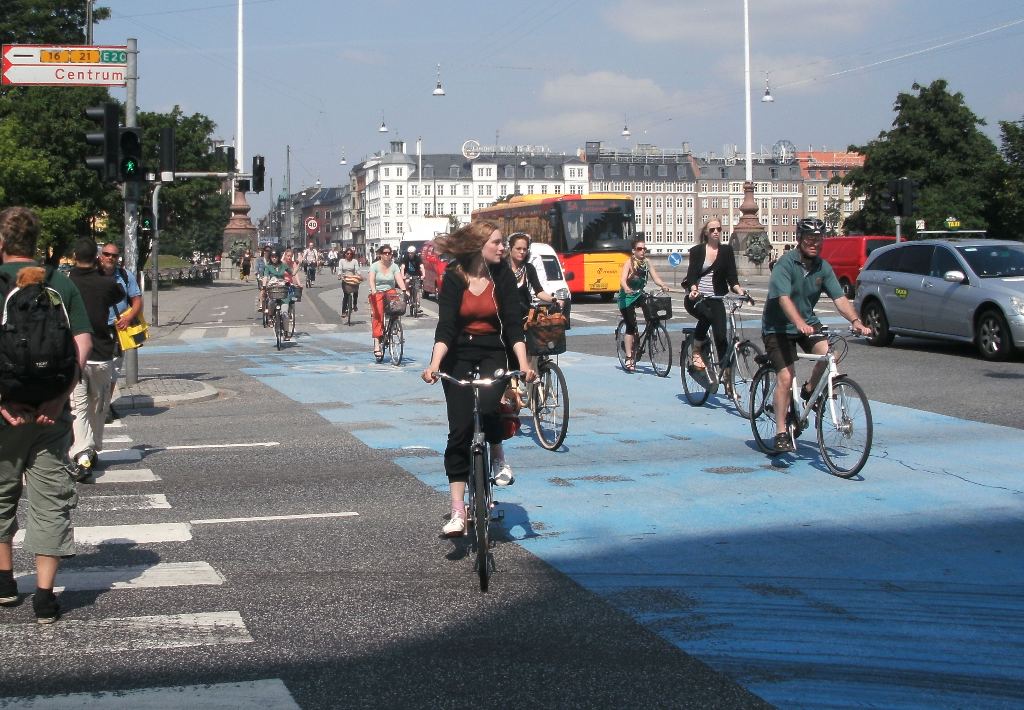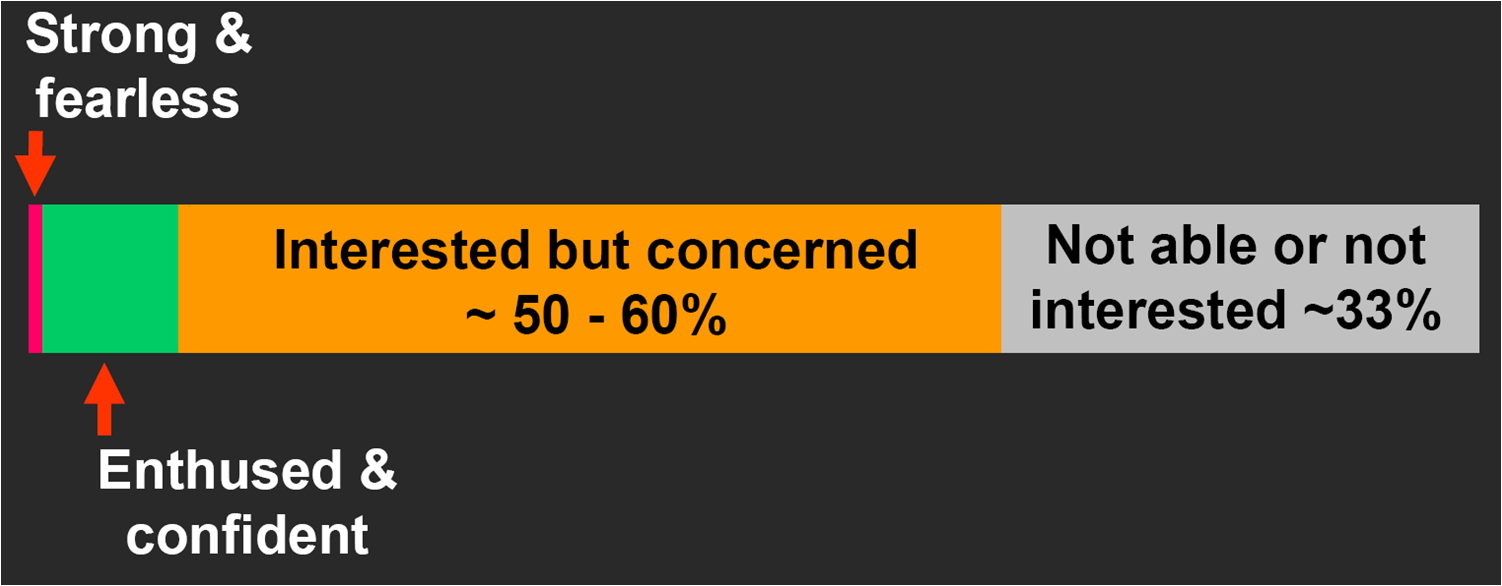One of the more useful concepts in modern cycle planning first came to NZ by way of a US cycle planner keynoting a NZ walking/cycling conference. It might seem odd that we would pick up a cycling lesson from car-centric America, but it’s understandable when you consider that they have been facing the same issues as us in trying to get a greater chunk of their population on their bikes. So it was that the “Four Types of Cyclist” were born (and now features in official NZTA guidance) and we first introduced these to CiC readers back in Nov 2012:
When trying to encourage more people to cycle, it’s helpful to “know your audience”. There’s an interesting theory that was developed in Portland, Oregon, to help understand who might want to cycle for transportation. Its intuitive logic has been so successful that many other places have also embraced its philosophy when considering their own would-be cycling populations. Some of you may have seen it before, but I think it’s helpful to repeat it here.
The so-called “Four Types” categorisation was first developed in 2005, as the City of Portland began to consider what it would take to dramatically increase bicycle use in Portland. City Bicycle Coordinator Roger Geller (who was out here earlier this year) is credited with having come up with the concept and putting up some numbers that seemed about right (and generally haven’t been contested much since). So here’s how it looks:

- Let’s start with the right-most group first – not able or not interested in cycling; otherwise known as the “No Way, No How” group. These are people who will not in the foreseeable future use a bike for transportation, even given the right conditions (although you may get some of them riding recreationally, perhaps in a mountain-bike park). It is estimated that maybe a third of your population might fall into this category, whether because of their physical limitations, social or cultural issues with cycling, or maybe logistical reasons. Standard travel behaviour theory says ignore this group for now – you have easier fish to fry…
- On to the far left, and that tiny sliver of people are known as the “Strong & Fearless”. This is your archetypal urban road warrior; nothing will stop them cycling from A to B, even if no facilities at all are provided. They are usually relatively immune to traffic concerns and often seem to be typically young and male. This group is probably no more than 1% of your population and that reflects the level of cycling you find even in cities with absolutely no provision for cycling (e.g. many parts of Auckland until recently). I suspect I probably fall into this category, but I realise that I’m not “normal” in that regard; in a former job I used to do things like stand in the middle of a high-speed highway with a survey pole, so traffic doesn’t bother me as much as it does to most people.
- Next over are the “Enthused & Confident”. For this group, some basic concessions of space for cycling will usually keep them happy. So a simple network of on-road cycle lanes (or just adequate shoulders) and intersection treatments will generally sustain this group. The proportion in this category might range between ~6-12%; funnily enough that mirrors what we find in Christchurch, which has historically based a lot of its cycling network on cycle lanes.
- Finally we come to the biggest group – the “Interested but Concerned”. This group wants to ride their bikes, but they have real issues with interacting with motor traffic. So they are looking for options that provide them with SLOW, LOW, or NO traffic, e.g. Vancouver’s separated bikeways and neighbourhood greenways. This desire came through very strongly in last year’s Share an Idea feedback, and reflects the huge untapped potential for people to cycle more if the right conditions are provided.
Since the initial development of the “Four Types” concept, various other groups have assessed it and generally found that it suits their needs too. Subsequent research has also tried to verify the size and nature of these four groups, e.g. this work by Portland State University. Even the recent NZ research on potential cyclists identified similar preferences for separated facilities when cycling.

Do you agree with these categories? Which type of cyclist are you?


I can’t decide if I am ‘Strong and Fearless’ or an ‘Enthused & Confident’.
I gave up riding for a few years due to not liking riding a ten speed on roads where there was too much gravel sitting on the sealed surface outside of where cars moved particularly at intersections if I was trying to turn left. Now I have bike with which I can do a small shop and it has wider tyers so the gravel doesn’t bother me as much.
We have limited cycle facilities and of low quality. I feel it’s a bit of a catch 22 we don’t have good facilities because not many cycle but we won’t get more cycling if council continues to believe that two white lines in the door zone of parked cars is a safe alternative to parents dropping their children off to school.
I know what is wrong with our road system and how it could be improved but due to economic and enviromental reasons and wanting cyclists to be seen in my town more often I’m not going to stop riding when I can.
Sorry to say, I fall into the brave or foolish side of this scale. As a teen biking with logging trucks on the Napier to Taupo Rd, so traffic is just another road user. Having an edge or shoulder to the road back then was a blessing for a slower pace, if no shoulder then the pace was fast and hard. One rule I learnt with cycling, for some reason drivers see a cyclist traveling at speed but not traveling slow. This may be a judgment problem as a slow cyclist can look like they are not moving, so fast moving drivers don’t pay interest until they see movement. So a cycle lane ok, but the problem is and will always be there if not addressed, no colouring or lighting will help if drivers are not paying attention when driving. Defensive driving teaches to watch for not just movement but if object on or near road if moved can cross your path, you must learn to read or judge the possibility of someone or something suddenly entering you path and know what path of action to take if it happens. So it’s not cycle paths ,its teaching drivers / cyclists and walkers to keep watch at all times and always stay focused. Then everyone will get to their point of travel safe and happy.